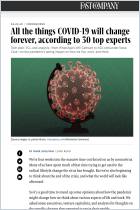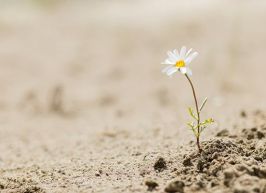Зарегистрируйтесь на getAbstract, чтобы получить доступ к этому краткому изложению.

Зарегистрируйтесь на getAbstract, чтобы получить доступ к этому краткому изложению.
Microsoft | Societal Resilience
Rethinking Our Shared Experiences
Resilience – Episode 2
Microsoft, 2021
Что внутри?
In Microsoft’s video “Rethinking our shared experiences,” the pandemic is a catalyst for community leaders and experts to come together to help build a more resilient society.
Recommendation
Times of crisis force people to evolve, adapt and innovate. As people converged to solve the deadly COVID-19 pandemic, societal barriers broke down as alternative perspectives were nurtured. Technology and science provided opportunities to “fuel discovery and magnify our ingenuity.” As part of its video series on societal resilience, Microsoft leaders tell personal stories and describe their own visions of how the pandemic is helping humanity to become more cohesive, caring and resilient.
Take-Aways
- The COVID-19 pandemic exacts both financial and psychological tolls.
- Working from home challenges people to stay connected in creative ways.
- Convalescent plasma became a community project in COVID-19’s early days.
- The pandemic exposed disparities in American demographic strata.
Summary
The COVID-19 pandemic takes both financial and psychological tolls.
Lila Tretikov, Microsoft’s corporate VP and deputy CTO, recalls that the pandemic seemed to cascade into reality almost overnight. Juan M. Lavista Ferres, chief scientist, Microsoft AI for Good Research Lab, sent an early, urgent email to his team, recommending that everyone work from home.
“I am an optimist. I don’t know if I’ve ever had my optimism shaken so hard, to be honest.” (Mary L. Gray, senior principal researcher, Microsoft Research)
Ashley Llorens, VP, distinguished scientist and managing director at Microsoft Research Outreach, says that it quickly became obvious that the pandemic battle would be engaged on many fronts, from understanding the science behind it to confronting “inherent societal consequences.”
“And then immediately, of course, your engineering mind goes to, ‘Okay, how can we fix this? How can we help?’” (Lila Tretikov, corporate VP and deputy CTO, Microsoft)
Lacking immediate, solid solutions, Microsoft leaders tasked themselves to use their expertise to explore COVID-19’s effects on human communities and individuals.
Working from home challenges people to stay connected in creative ways.
Microsoft team members considered ways that people connect through communication technologies. They discovered that these technologies help define “who we are and how we live,” and that studying such relationships reveals how people encompass the complicated ways people live in the world.
“I think that everything that happened last year is very hard to understand, in terms of technology, people and relationships, because we were all traumatized and living through a completely surreal experience – losing our sense of reality.” (Nancy Baym, senior principal research manager, Microsoft)
The Work Trend Index takes the global workforce pulse to illustrate how the modern workplace is changing. The index compiled a survey of approximately 300,000 workers in 19 countries. The study revealed that today’s workers attend more meetings, receive more messages and spend more hours at work than in years past. They continuously stare at screens.
When people work both in an office and at home, they lose some social capital built through informal, spontaneous interactions. Because people are social by nature, those working from home miss the personal relationships built through “caring for one another.” Even social distancing, over time, exacts a cost.
“We keep talking about the new future of work. We’re saying, we don’t want to go back to normal. We want to build a better future. We want a new, better work.” (Nancy Baym)
People working from home, especially new hires, struggle to feel connected to their work and can experience problems fitting into their work environments. Working from home as a personal choice is different from being forced to work there during a pandemic. Loneliness and dissatisfaction can grow.
“We had that privilege to be able to sit in our homes, while people who didn’t have that same privilege risked their lives.” (Jabran Zahid, senior researcher, Immunomics Group, Microsoft)
Frontline workers, including medical personnel, grocery workers and delivery drivers, have kept society running during COVID-19. Sometimes after a crisis is over, people forget such laudable sacrifices. New economic models must be constructed in which everyone is valued, especially those who care for others while taking personal risks.
Convalescent plasma became a community project in the early days of COVID-19.
Many organizations were desperately seeking a cure for the virus. One group explored a century-old therapy called convalescent plasma, used during the 1918 Spanish flu pandemic. Researchers and scientists came together to save lives. Rigorous studies were completed in record time, under a variety of challenging circumstances. Community leaders were invited to forums with scientists, medical institutions and doctors, all working with similar data to solve the same problem.
The pandemic exposed disparities in American demographic strata.
There is no valid biological reason that death rates from COVID-19 are three times higher for people of color than for others.
“The stark statistics on who was dying versus who was living, based on socioeconomic situation, will frame a long-term and powerful discussion about our society.” (Dr. Eric Horvitz, chief scientific officer, Microsoft)
The pandemic exposed numerous societal disparities, proving that people must build an equitable world that doesn’t discriminate based on differences. Engineering and science are increasingly involved in such societal issues.
A doctor involved in Microsoft’s Greenlight Ready program texted Mary L. Gray, senior principal researcher at Microsoft Research, that he felt a workflow problem existed in treating marginalized groups suffering from COVID-19. His suggestion was to better equip such communities with needed resources so they can better care for each other.
The organization began to hold “vaccine expos” in brown and Black communities, particularly for undocumented workers who are reluctant to go to public hospitals. In this way, people could confidentially reach out to trusted organizations to seek help. Greenlight Ready vaccinated many people who would never have gone to a public medical facility. Science can help positively change the world, but scientists must empathize with others to envision a world worth inhabiting.
“When we think that technologies are going to offer the solutions, and therefore we don’t have to worry about the social part, it doesn’t allow us to really confront those problems.” (Nancy Baym)
The pandemic has created an opportunity for critical conversations, where people listen to each other and ask significant questions. Building a healthier society requires an equitable approach that does not just reinforce existing health systems, but sprouts from communities. A balance must be found in preserving and reimagining society as it reopens.
“I want to look back at this moment and say, this is when we started building out public health care from the ground up. That we literally said, oh, communities, that’s where care happens.” (Mary L. Gray)
If there is one bright side of the pandemic, it’s that people helped each other by starting “mutual aid networks.” People of all walks of life truly cared for one another, and took responsibility for one another. Hopefully those feelings and actions can be retained in the future. Lila Tretikov cites the old proverb, “We don’t inherit the Earth from our parents, we borrow it from our children.”
About the Speaker
Microsoft Corporation is an American multinational technology corporation that creates computer software, consumer electronics, personal computers, and related services.
This document is restricted to personal use only.



















Comment on this summary